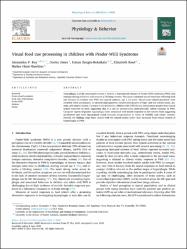| dc.contributor.author | Key, Alexandra P. | |
| dc.contributor.author | Jones, Dorita | |
| dc.contributor.author | Zengin Bolatkale, Hatun | |
| dc.contributor.author | Roof, Elizabeth | |
| dc.contributor.author | Hunt-Hawkins, Hailee | |
| dc.date.accessioned | 2021-08-05T09:31:11Z | |
| dc.date.available | 2021-08-05T09:31:11Z | |
| dc.date.issued | 2021 | en_US |
| dc.identifier.citation | Key, A. P., Jones, D., Zengin Bolatkale, H., Roof, E. ve Hunt Hawkins, H. (2021). Visual food cue processing in children with prader-willi syndrome. Physiology & Behavior, 238. https://dx.doi.org/10.1016/j.physbeh.2021.113492 | en_US |
| dc.identifier.issn | 0031-9384 | |
| dc.identifier.issn | 1873-507X | |
| dc.identifier.uri | https://dx.doi.org/10.1016/j.physbeh.2021.113492 | |
| dc.identifier.uri | https://hdl.handle.net/20.500.12511/7689 | |
| dc.description.abstract | Hyperphagia and the associated interest in food is a characteristic feature of Prader-Willi syndrome (PWS) that emerges during childhood and remains a life-long concern. This study examined neural responses reflecting food cue salience in children with PWS and typical controls, age 3-12 years. Visual event-related potentials were recorded while participants in satiated state passively viewed photographs of high- and low-calorie foods, animals, and neutral objects. Contrary to the prediction, children with PWS did not demonstrate greater than typical neural responses to food, suggesting that it is not an exceptionally motivationally salient stimulus in PWS. Caregiver reports of greater hyperphagia were associated with neural responses to low-calorie foods suggesting accelerated and more fine-grained visual stimulus categorization in terms of edibility and caloric content. Overall, the findings align more closely with the altered satiety rather than increased food reward models of hyperphagia in PWS. | en_US |
| dc.description.sponsorship | Foundation for Prader-Willi Research ; United States Department of Health & Human Services ; National Institutes of Health (NIH) - USA ; NIH Eunice Kennedy Shriver National Institute of Child Health & Human Development (NICHD) | en_US |
| dc.language.iso | eng | en_US |
| dc.publisher | Elsevier Inc. | en_US |
| dc.rights | info:eu-repo/semantics/embargoedAccess | en_US |
| dc.subject | Event-Related Potentials | en_US |
| dc.subject | Food Cues | en_US |
| dc.subject | Hyperphagia | en_US |
| dc.subject | Prader-Willi | en_US |
| dc.subject | Salience | en_US |
| dc.subject | Satiety | en_US |
| dc.title | Visual food cue processing in children with prader-willi syndrome | en_US |
| dc.type | article | en_US |
| dc.relation.ispartof | Physiology & Behavior | en_US |
| dc.department | İstanbul Medipol Üniversitesi, Sağlık Bilimleri Fakültesi, Dil ve Konuşma Terapisi Bölümü | en_US |
| dc.authorid | 0000-0003-2681-7150 | en_US |
| dc.identifier.volume | 238 | en_US |
| dc.relation.publicationcategory | Makale - Uluslararası Hakemli Dergi - Kurum Öğretim Elemanı | en_US |
| dc.identifier.doi | 10.1016/j.physbeh.2021.113492 | en_US |
| dc.identifier.wosquality | Q2 | en_US |
| dc.identifier.scopusquality | Q2 | en_US |


















